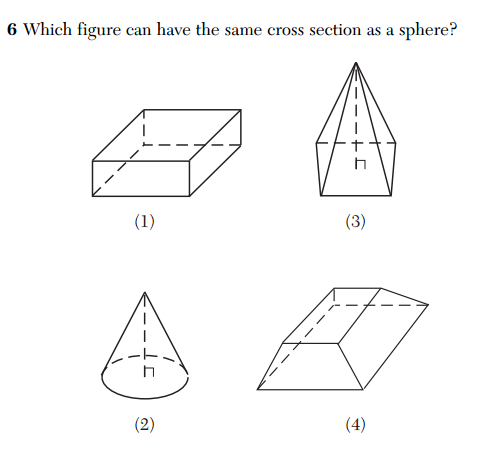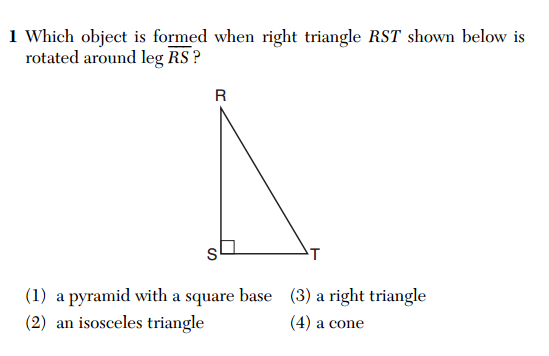Regents Recap — June 2015: Trouble with 3D Geometry
Here is another installment in my series reviewing the NY State Regents exams in mathematics.
The Common Core standards have brought a slight increase in three dimensional reasoning into high school Geometry. I think this is generally a good thing: 3D geometry is typically given short shrift in this course, but is a beautiful and intriguing topic.
It can also be a confusing topic, as these problems from the inaugural Common Core Geometry Regents exam demonstrate.
According to the scoring guide, the correct answer is (4) a cone. Technically, however, the correct answer is (3) a right triangle.
Rotation is a rigid motion: it does not change a figure’s size or shape. If a right triangle is rotated about an axis, it will remain a right triangle. Presumably, the intent of this question is for the student to identify the solid of revolution formed by revolving the triangle about an axis. But that is a different question than the one posed. Ironically, the notion that rigid motions preserve size and shape is one of the fundamental principles in the transformation-based approach to geometry embodied by the Common Core standards.
Here’s another problematic 3D geometry question.
According to the answer key, the correct answer is (2). But the actual correct answer is all of these. While most cross-sections of spheres are circles, some cross-sections of spheres are single points (when the cross-sectional plane is tangent to the sphere). All the given objects have single point cross-sections as well, thus, could all have the same cross section as a sphere.
This is certainly not the first time we’ve seen problematic three dimensional geometry questions on these Regents exams (here’s a particularly embarrassing example), and I’ve been chronicling mathematically erroneous questions on these tests for years. Errors like this are often dismissed as insignificant, or “typos”, but because of the high-stakes nature of these exams, these errors have real consequences for students and teachers.
If these exams don’t model exemplary mathematics and mathematical practice, their credibility in evaluating the mathematical practice of students and teachers must be questioned.

4 Comments
carlos gomez · July 16, 2015 at 8:20 pm
These exact issues were brought up by Math Department Chairs from the Lower Hudson Region of Westchester! I believe our faciliator E-Mailed the NYSED about it. We were all encouraged to write E-Mails as well. I am almost certain that my E-Mail is sitting in an inbox somewhere.
MrHonner · July 17, 2015 at 9:36 am
I always wonder to what extent other math teachers share my concerns about these matters. Thanks for sharing, Carlos!
Trevor · February 27, 2018 at 11:49 pm
I completely agree with the justification in regards to the right triangle shown in question 1, but the question itself is specifically asking for an object (i.e. 3-D figure, in their eyes). Would your opinion change? Or do you believe this question is still worded incorrectly with a lack of understanding?
MrHonner · February 28, 2018 at 8:52 am
The key part of your question is the parenthetical “in their eyes”. Why should the result have to be a 3D object? When you rotate a triangle, the result is a triangle. And that is an answer choice!
In retrospect, we can guess what they meant to ask, but that’s not what they actually asked. In any event, it shouldn’t be the student’s responsibility to figure out what they meant to ask.